International Finance Report: Woodside Petroleum and Macquarie Group
VerifiedAdded on 2021/04/20
|11
|1682
|38
Report
AI Summary
This report provides an analysis of international finance, focusing on two Australian companies: Woodside Petroleum and Macquarie Group. The report begins with a scenario-based analysis of investment decisions in Thailand, considering interest rates and currency depreciation, and evaluates the financial implications of remitting funds versus reinvesting. Part B of the report examines the companies' financial operations, including their revenue sources, foreign exchange risks, and risk management strategies. It investigates the relationship between the companies' share prices and exchange rates, highlighting the sensitivity of each company to currency fluctuations. The report concludes by discussing the potential benefits of secondary listings for both companies and recommending strategic listing locations based on their revenue streams, offering insights into international financial management and risk mitigation. The report also includes references to relevant literature.
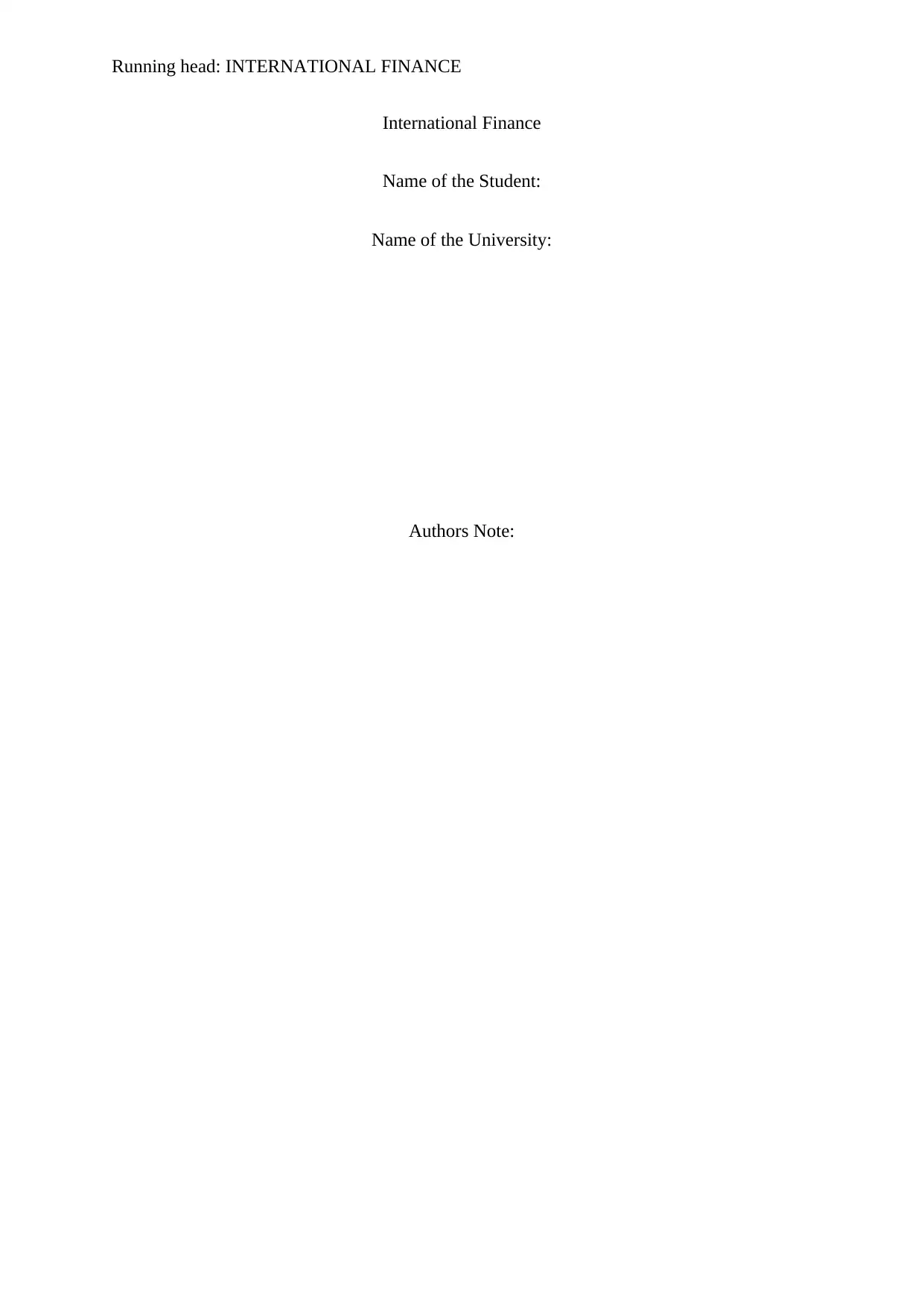
Running head: INTERNATIONAL FINANCE
International Finance
Name of the Student:
Name of the University:
Authors Note:
International Finance
Name of the Student:
Name of the University:
Authors Note:
Paraphrase This Document
Need a fresh take? Get an instant paraphrase of this document with our AI Paraphraser
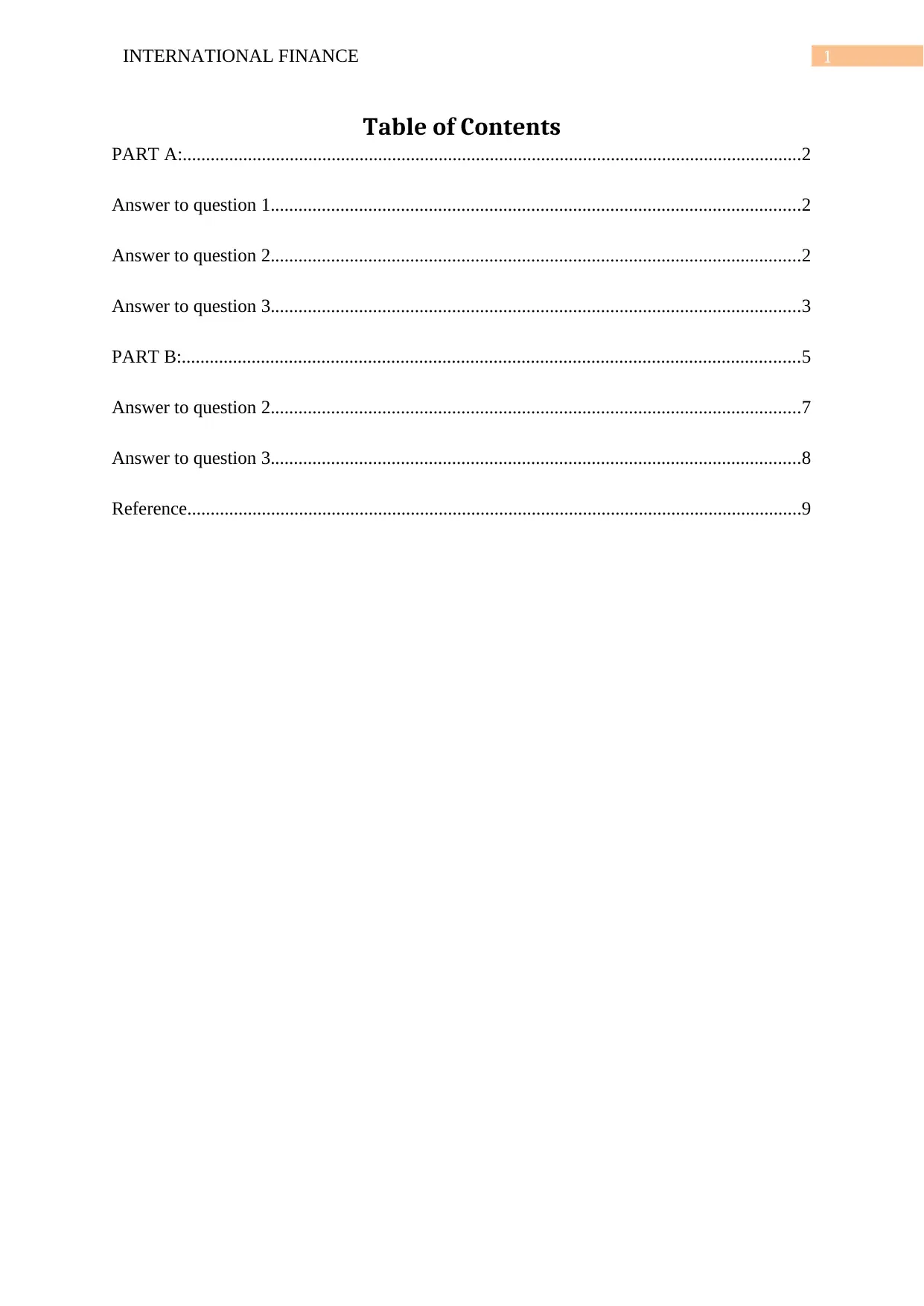
1INTERNATIONAL FINANCE
Table of Contents
PART A:.....................................................................................................................................2
Answer to question 1..................................................................................................................2
Answer to question 2..................................................................................................................2
Answer to question 3..................................................................................................................3
PART B:.....................................................................................................................................5
Answer to question 2..................................................................................................................7
Answer to question 3..................................................................................................................8
Reference....................................................................................................................................9
Table of Contents
PART A:.....................................................................................................................................2
Answer to question 1..................................................................................................................2
Answer to question 2..................................................................................................................2
Answer to question 3..................................................................................................................3
PART B:.....................................................................................................................................5
Answer to question 2..................................................................................................................7
Answer to question 3..................................................................................................................8
Reference....................................................................................................................................9
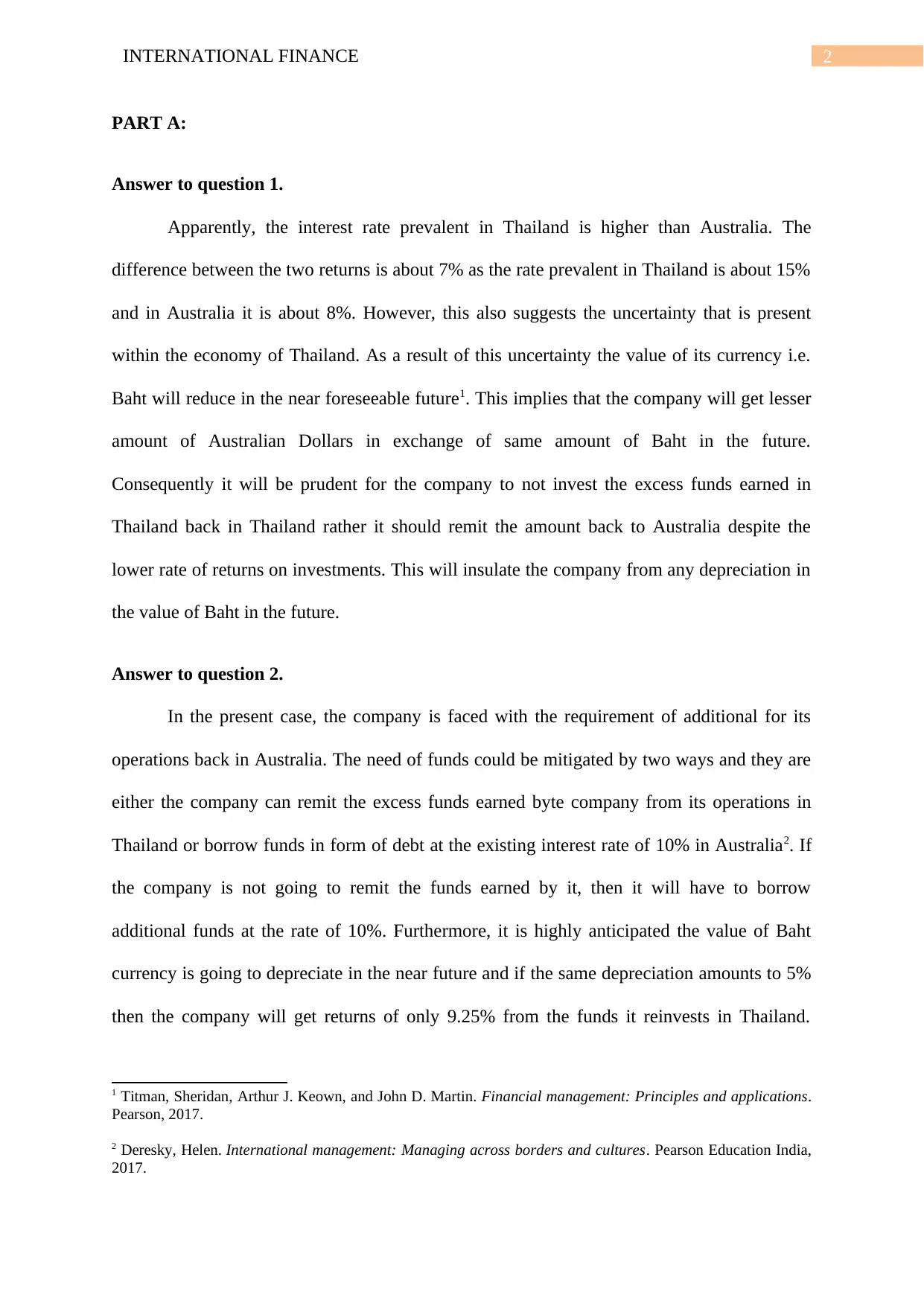
2INTERNATIONAL FINANCE
PART A:
Answer to question 1.
Apparently, the interest rate prevalent in Thailand is higher than Australia. The
difference between the two returns is about 7% as the rate prevalent in Thailand is about 15%
and in Australia it is about 8%. However, this also suggests the uncertainty that is present
within the economy of Thailand. As a result of this uncertainty the value of its currency i.e.
Baht will reduce in the near foreseeable future1. This implies that the company will get lesser
amount of Australian Dollars in exchange of same amount of Baht in the future.
Consequently it will be prudent for the company to not invest the excess funds earned in
Thailand back in Thailand rather it should remit the amount back to Australia despite the
lower rate of returns on investments. This will insulate the company from any depreciation in
the value of Baht in the future.
Answer to question 2.
In the present case, the company is faced with the requirement of additional for its
operations back in Australia. The need of funds could be mitigated by two ways and they are
either the company can remit the excess funds earned byte company from its operations in
Thailand or borrow funds in form of debt at the existing interest rate of 10% in Australia2. If
the company is not going to remit the funds earned by it, then it will have to borrow
additional funds at the rate of 10%. Furthermore, it is highly anticipated the value of Baht
currency is going to depreciate in the near future and if the same depreciation amounts to 5%
then the company will get returns of only 9.25% from the funds it reinvests in Thailand.
1 Titman, Sheridan, Arthur J. Keown, and John D. Martin. Financial management: Principles and applications.
Pearson, 2017.
2 Deresky, Helen. International management: Managing across borders and cultures. Pearson Education India,
2017.
PART A:
Answer to question 1.
Apparently, the interest rate prevalent in Thailand is higher than Australia. The
difference between the two returns is about 7% as the rate prevalent in Thailand is about 15%
and in Australia it is about 8%. However, this also suggests the uncertainty that is present
within the economy of Thailand. As a result of this uncertainty the value of its currency i.e.
Baht will reduce in the near foreseeable future1. This implies that the company will get lesser
amount of Australian Dollars in exchange of same amount of Baht in the future.
Consequently it will be prudent for the company to not invest the excess funds earned in
Thailand back in Thailand rather it should remit the amount back to Australia despite the
lower rate of returns on investments. This will insulate the company from any depreciation in
the value of Baht in the future.
Answer to question 2.
In the present case, the company is faced with the requirement of additional for its
operations back in Australia. The need of funds could be mitigated by two ways and they are
either the company can remit the excess funds earned byte company from its operations in
Thailand or borrow funds in form of debt at the existing interest rate of 10% in Australia2. If
the company is not going to remit the funds earned by it, then it will have to borrow
additional funds at the rate of 10%. Furthermore, it is highly anticipated the value of Baht
currency is going to depreciate in the near future and if the same depreciation amounts to 5%
then the company will get returns of only 9.25% from the funds it reinvests in Thailand.
1 Titman, Sheridan, Arthur J. Keown, and John D. Martin. Financial management: Principles and applications.
Pearson, 2017.
2 Deresky, Helen. International management: Managing across borders and cultures. Pearson Education India,
2017.
⊘ This is a preview!⊘
Do you want full access?
Subscribe today to unlock all pages.

Trusted by 1+ million students worldwide
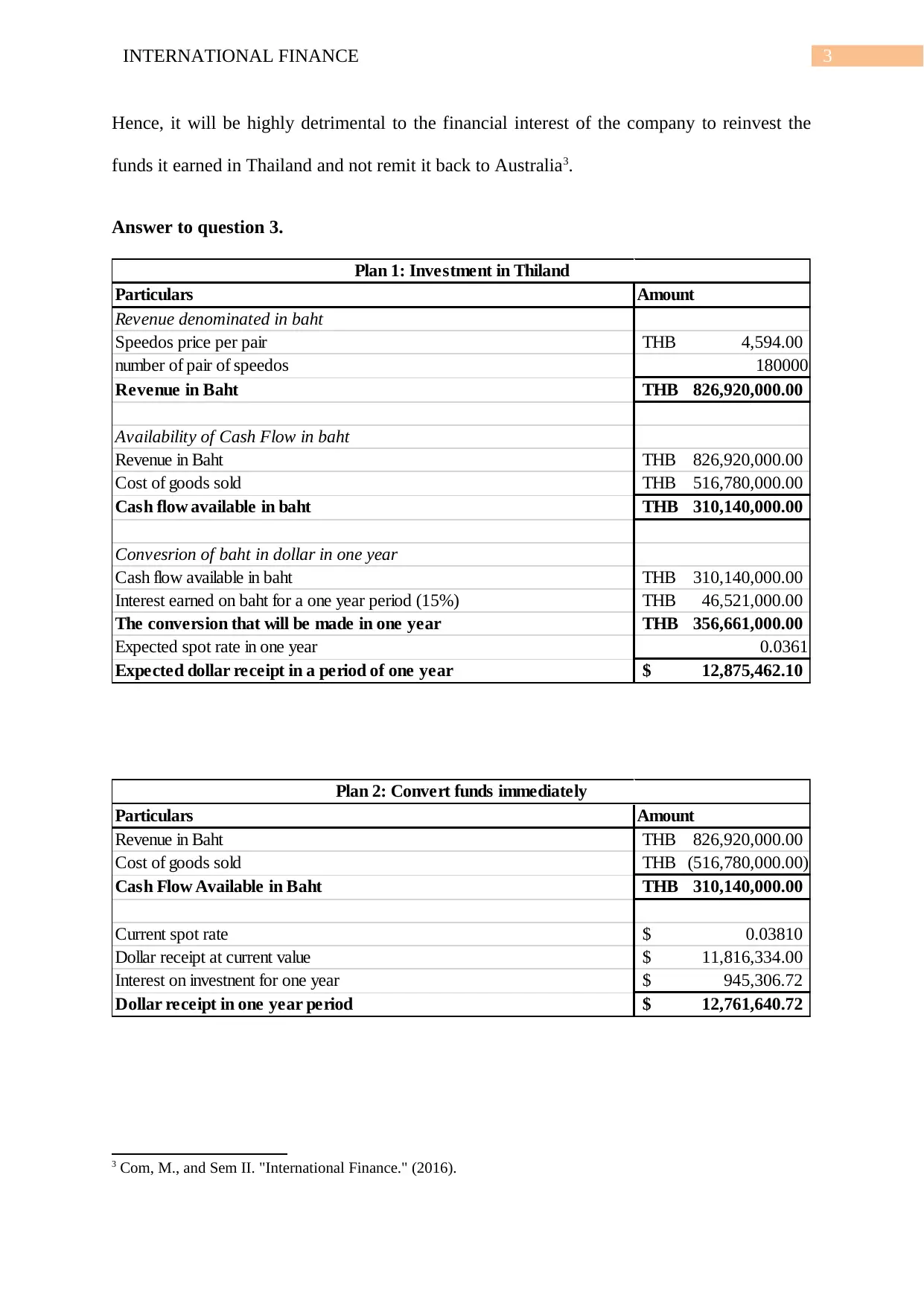
3INTERNATIONAL FINANCE
Hence, it will be highly detrimental to the financial interest of the company to reinvest the
funds it earned in Thailand and not remit it back to Australia3.
Answer to question 3.
Particulars Amount
Revenue denominated in baht
Speedos price per pair 4,594.00THB
number of pair of speedos 180000
Revenue in Baht 826,920,000.00THB
Availability of Cash Flow in baht
Revenue in Baht 826,920,000.00THB
Cost of goods sold 516,780,000.00THB
Cash flow available in baht 310,140,000.00THB
Convesrion of baht in dollar in one year
Cash flow available in baht 310,140,000.00THB
Interest earned on baht for a one year period (15%) 46,521,000.00THB
The conversion that will be made in one year 356,661,000.00THB
Expected spot rate in one year 0.0361
Expected dollar receipt in a period of one year 12,875,462.10$
Plan 1: Investment in Thiland
Particulars Amount
Revenue in Baht 826,920,000.00THB
Cost of goods sold (516,780,000.00)THB
Cash Flow Available in Baht 310,140,000.00THB
Current spot rate 0.03810$
Dollar receipt at current value 11,816,334.00$
Interest on investnent for one year 945,306.72$
Dollar receipt in one year period 12,761,640.72$
Plan 2: Convert funds immediately
3 Com, M., and Sem II. "International Finance." (2016).
Hence, it will be highly detrimental to the financial interest of the company to reinvest the
funds it earned in Thailand and not remit it back to Australia3.
Answer to question 3.
Particulars Amount
Revenue denominated in baht
Speedos price per pair 4,594.00THB
number of pair of speedos 180000
Revenue in Baht 826,920,000.00THB
Availability of Cash Flow in baht
Revenue in Baht 826,920,000.00THB
Cost of goods sold 516,780,000.00THB
Cash flow available in baht 310,140,000.00THB
Convesrion of baht in dollar in one year
Cash flow available in baht 310,140,000.00THB
Interest earned on baht for a one year period (15%) 46,521,000.00THB
The conversion that will be made in one year 356,661,000.00THB
Expected spot rate in one year 0.0361
Expected dollar receipt in a period of one year 12,875,462.10$
Plan 1: Investment in Thiland
Particulars Amount
Revenue in Baht 826,920,000.00THB
Cost of goods sold (516,780,000.00)THB
Cash Flow Available in Baht 310,140,000.00THB
Current spot rate 0.03810$
Dollar receipt at current value 11,816,334.00$
Interest on investnent for one year 945,306.72$
Dollar receipt in one year period 12,761,640.72$
Plan 2: Convert funds immediately
3 Com, M., and Sem II. "International Finance." (2016).
Paraphrase This Document
Need a fresh take? Get an instant paraphrase of this document with our AI Paraphraser
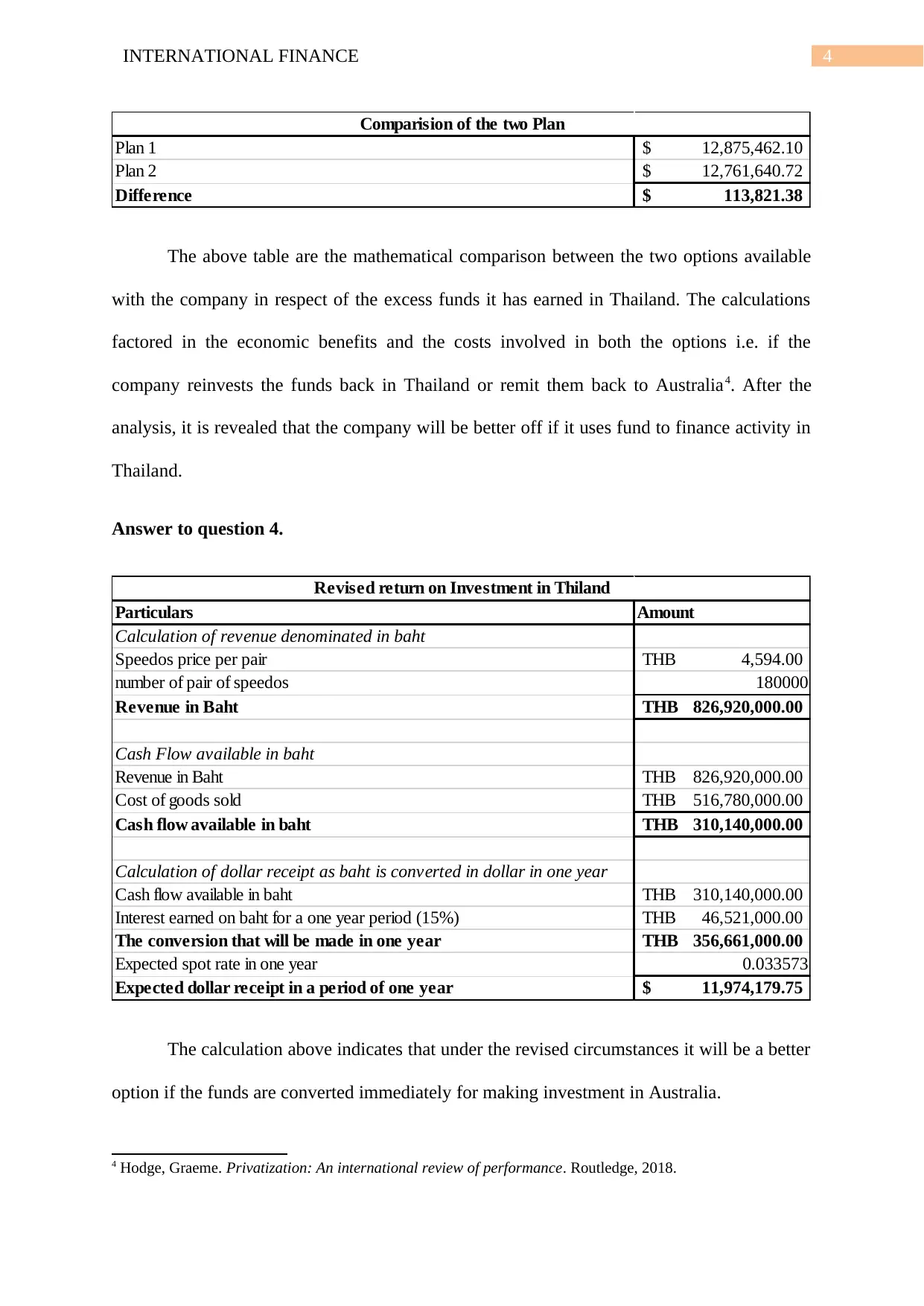
4INTERNATIONAL FINANCE
Plan 1 12,875,462.10$
Plan 2 12,761,640.72$
Difference 113,821.38$
Comparision of the two Plan
The above table are the mathematical comparison between the two options available
with the company in respect of the excess funds it has earned in Thailand. The calculations
factored in the economic benefits and the costs involved in both the options i.e. if the
company reinvests the funds back in Thailand or remit them back to Australia4. After the
analysis, it is revealed that the company will be better off if it uses fund to finance activity in
Thailand.
Answer to question 4.
Particulars Amount
Calculation of revenue denominated in baht
Speedos price per pair 4,594.00THB
number of pair of speedos 180000
Revenue in Baht 826,920,000.00THB
Cash Flow available in baht
Revenue in Baht 826,920,000.00THB
Cost of goods sold 516,780,000.00THB
Cash flow available in baht 310,140,000.00THB
Calculation of dollar receipt as baht is converted in dollar in one year
Cash flow available in baht 310,140,000.00THB
Interest earned on baht for a one year period (15%) 46,521,000.00THB
The conversion that will be made in one year 356,661,000.00THB
Expected spot rate in one year 0.033573
Expected dollar receipt in a period of one year 11,974,179.75$
Revised return on Investment in Thiland
The calculation above indicates that under the revised circumstances it will be a better
option if the funds are converted immediately for making investment in Australia.
4 Hodge, Graeme. Privatization: An international review of performance. Routledge, 2018.
Plan 1 12,875,462.10$
Plan 2 12,761,640.72$
Difference 113,821.38$
Comparision of the two Plan
The above table are the mathematical comparison between the two options available
with the company in respect of the excess funds it has earned in Thailand. The calculations
factored in the economic benefits and the costs involved in both the options i.e. if the
company reinvests the funds back in Thailand or remit them back to Australia4. After the
analysis, it is revealed that the company will be better off if it uses fund to finance activity in
Thailand.
Answer to question 4.
Particulars Amount
Calculation of revenue denominated in baht
Speedos price per pair 4,594.00THB
number of pair of speedos 180000
Revenue in Baht 826,920,000.00THB
Cash Flow available in baht
Revenue in Baht 826,920,000.00THB
Cost of goods sold 516,780,000.00THB
Cash flow available in baht 310,140,000.00THB
Calculation of dollar receipt as baht is converted in dollar in one year
Cash flow available in baht 310,140,000.00THB
Interest earned on baht for a one year period (15%) 46,521,000.00THB
The conversion that will be made in one year 356,661,000.00THB
Expected spot rate in one year 0.033573
Expected dollar receipt in a period of one year 11,974,179.75$
Revised return on Investment in Thiland
The calculation above indicates that under the revised circumstances it will be a better
option if the funds are converted immediately for making investment in Australia.
4 Hodge, Graeme. Privatization: An international review of performance. Routledge, 2018.
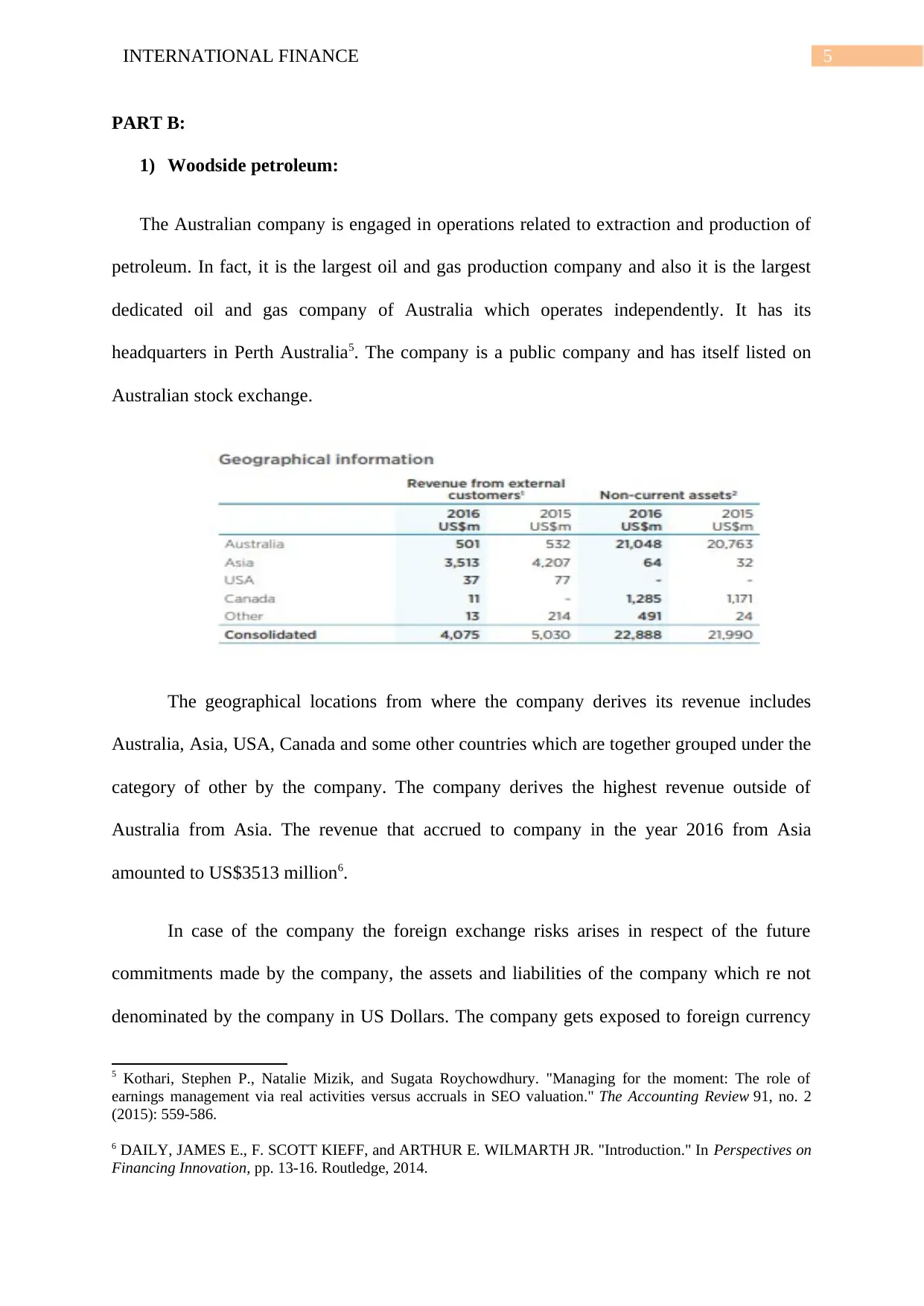
5INTERNATIONAL FINANCE
PART B:
1) Woodside petroleum:
The Australian company is engaged in operations related to extraction and production of
petroleum. In fact, it is the largest oil and gas production company and also it is the largest
dedicated oil and gas company of Australia which operates independently. It has its
headquarters in Perth Australia5. The company is a public company and has itself listed on
Australian stock exchange.
The geographical locations from where the company derives its revenue includes
Australia, Asia, USA, Canada and some other countries which are together grouped under the
category of other by the company. The company derives the highest revenue outside of
Australia from Asia. The revenue that accrued to company in the year 2016 from Asia
amounted to US$3513 million6.
In case of the company the foreign exchange risks arises in respect of the future
commitments made by the company, the assets and liabilities of the company which re not
denominated by the company in US Dollars. The company gets exposed to foreign currency
5 Kothari, Stephen P., Natalie Mizik, and Sugata Roychowdhury. "Managing for the moment: The role of
earnings management via real activities versus accruals in SEO valuation." The Accounting Review 91, no. 2
(2015): 559-586.
6 DAILY, JAMES E., F. SCOTT KIEFF, and ARTHUR E. WILMARTH JR. "Introduction." In Perspectives on
Financing Innovation, pp. 13-16. Routledge, 2014.
PART B:
1) Woodside petroleum:
The Australian company is engaged in operations related to extraction and production of
petroleum. In fact, it is the largest oil and gas production company and also it is the largest
dedicated oil and gas company of Australia which operates independently. It has its
headquarters in Perth Australia5. The company is a public company and has itself listed on
Australian stock exchange.
The geographical locations from where the company derives its revenue includes
Australia, Asia, USA, Canada and some other countries which are together grouped under the
category of other by the company. The company derives the highest revenue outside of
Australia from Asia. The revenue that accrued to company in the year 2016 from Asia
amounted to US$3513 million6.
In case of the company the foreign exchange risks arises in respect of the future
commitments made by the company, the assets and liabilities of the company which re not
denominated by the company in US Dollars. The company gets exposed to foreign currency
5 Kothari, Stephen P., Natalie Mizik, and Sugata Roychowdhury. "Managing for the moment: The role of
earnings management via real activities versus accruals in SEO valuation." The Accounting Review 91, no. 2
(2015): 559-586.
6 DAILY, JAMES E., F. SCOTT KIEFF, and ARTHUR E. WILMARTH JR. "Introduction." In Perspectives on
Financing Innovation, pp. 13-16. Routledge, 2014.
⊘ This is a preview!⊘
Do you want full access?
Subscribe today to unlock all pages.

Trusted by 1+ million students worldwide
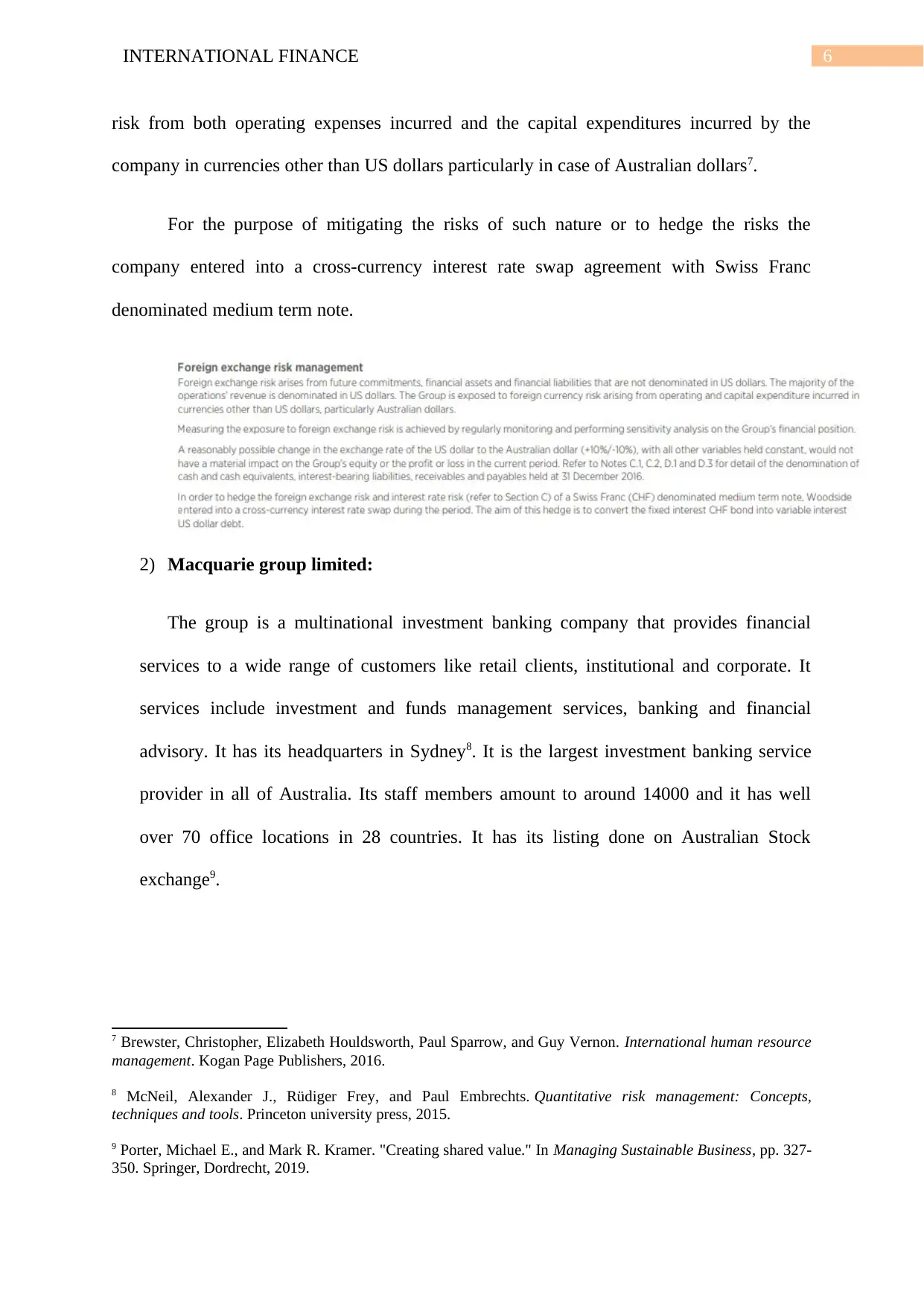
6INTERNATIONAL FINANCE
risk from both operating expenses incurred and the capital expenditures incurred by the
company in currencies other than US dollars particularly in case of Australian dollars7.
For the purpose of mitigating the risks of such nature or to hedge the risks the
company entered into a cross-currency interest rate swap agreement with Swiss Franc
denominated medium term note.
2) Macquarie group limited:
The group is a multinational investment banking company that provides financial
services to a wide range of customers like retail clients, institutional and corporate. It
services include investment and funds management services, banking and financial
advisory. It has its headquarters in Sydney8. It is the largest investment banking service
provider in all of Australia. Its staff members amount to around 14000 and it has well
over 70 office locations in 28 countries. It has its listing done on Australian Stock
exchange9.
7 Brewster, Christopher, Elizabeth Houldsworth, Paul Sparrow, and Guy Vernon. International human resource
management. Kogan Page Publishers, 2016.
8 McNeil, Alexander J., Rüdiger Frey, and Paul Embrechts. Quantitative risk management: Concepts,
techniques and tools. Princeton university press, 2015.
9 Porter, Michael E., and Mark R. Kramer. "Creating shared value." In Managing Sustainable Business, pp. 327-
350. Springer, Dordrecht, 2019.
risk from both operating expenses incurred and the capital expenditures incurred by the
company in currencies other than US dollars particularly in case of Australian dollars7.
For the purpose of mitigating the risks of such nature or to hedge the risks the
company entered into a cross-currency interest rate swap agreement with Swiss Franc
denominated medium term note.
2) Macquarie group limited:
The group is a multinational investment banking company that provides financial
services to a wide range of customers like retail clients, institutional and corporate. It
services include investment and funds management services, banking and financial
advisory. It has its headquarters in Sydney8. It is the largest investment banking service
provider in all of Australia. Its staff members amount to around 14000 and it has well
over 70 office locations in 28 countries. It has its listing done on Australian Stock
exchange9.
7 Brewster, Christopher, Elizabeth Houldsworth, Paul Sparrow, and Guy Vernon. International human resource
management. Kogan Page Publishers, 2016.
8 McNeil, Alexander J., Rüdiger Frey, and Paul Embrechts. Quantitative risk management: Concepts,
techniques and tools. Princeton university press, 2015.
9 Porter, Michael E., and Mark R. Kramer. "Creating shared value." In Managing Sustainable Business, pp. 327-
350. Springer, Dordrecht, 2019.
Paraphrase This Document
Need a fresh take? Get an instant paraphrase of this document with our AI Paraphraser
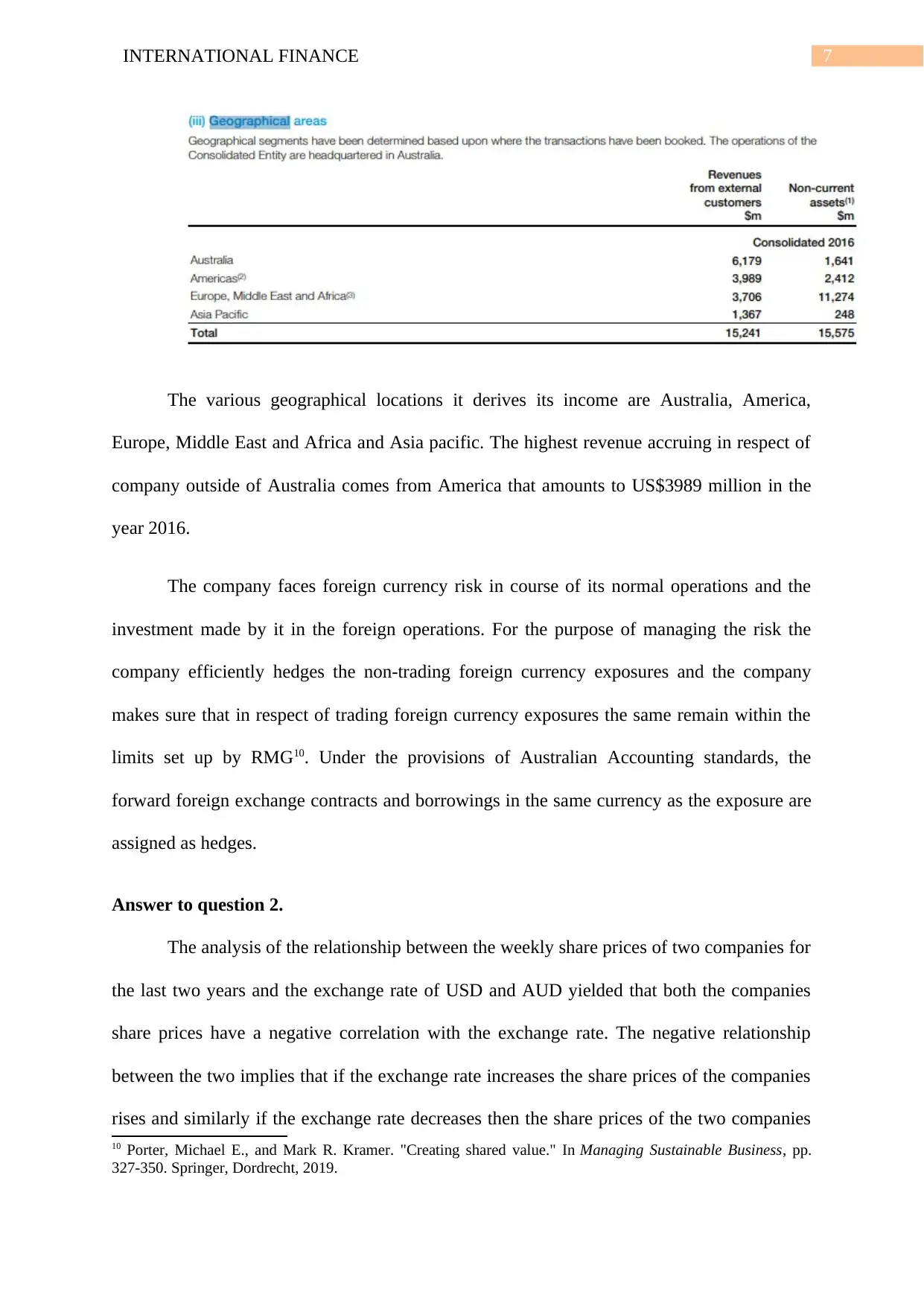
7INTERNATIONAL FINANCE
The various geographical locations it derives its income are Australia, America,
Europe, Middle East and Africa and Asia pacific. The highest revenue accruing in respect of
company outside of Australia comes from America that amounts to US$3989 million in the
year 2016.
The company faces foreign currency risk in course of its normal operations and the
investment made by it in the foreign operations. For the purpose of managing the risk the
company efficiently hedges the non-trading foreign currency exposures and the company
makes sure that in respect of trading foreign currency exposures the same remain within the
limits set up by RMG10. Under the provisions of Australian Accounting standards, the
forward foreign exchange contracts and borrowings in the same currency as the exposure are
assigned as hedges.
Answer to question 2.
The analysis of the relationship between the weekly share prices of two companies for
the last two years and the exchange rate of USD and AUD yielded that both the companies
share prices have a negative correlation with the exchange rate. The negative relationship
between the two implies that if the exchange rate increases the share prices of the companies
rises and similarly if the exchange rate decreases then the share prices of the two companies
10 Porter, Michael E., and Mark R. Kramer. "Creating shared value." In Managing Sustainable Business, pp.
327-350. Springer, Dordrecht, 2019.
The various geographical locations it derives its income are Australia, America,
Europe, Middle East and Africa and Asia pacific. The highest revenue accruing in respect of
company outside of Australia comes from America that amounts to US$3989 million in the
year 2016.
The company faces foreign currency risk in course of its normal operations and the
investment made by it in the foreign operations. For the purpose of managing the risk the
company efficiently hedges the non-trading foreign currency exposures and the company
makes sure that in respect of trading foreign currency exposures the same remain within the
limits set up by RMG10. Under the provisions of Australian Accounting standards, the
forward foreign exchange contracts and borrowings in the same currency as the exposure are
assigned as hedges.
Answer to question 2.
The analysis of the relationship between the weekly share prices of two companies for
the last two years and the exchange rate of USD and AUD yielded that both the companies
share prices have a negative correlation with the exchange rate. The negative relationship
between the two implies that if the exchange rate increases the share prices of the companies
rises and similarly if the exchange rate decreases then the share prices of the two companies
10 Porter, Michael E., and Mark R. Kramer. "Creating shared value." In Managing Sustainable Business, pp.
327-350. Springer, Dordrecht, 2019.
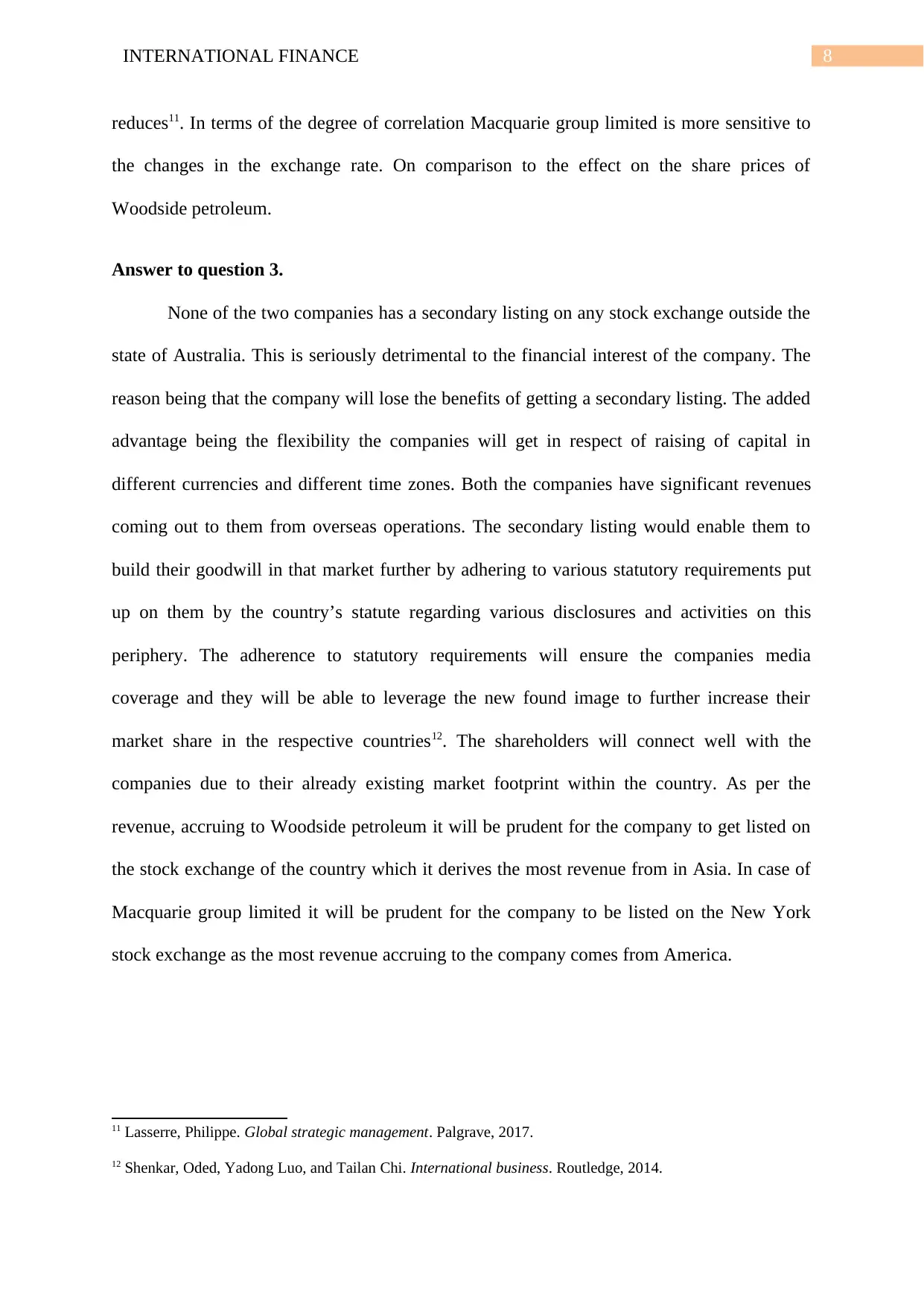
8INTERNATIONAL FINANCE
reduces11. In terms of the degree of correlation Macquarie group limited is more sensitive to
the changes in the exchange rate. On comparison to the effect on the share prices of
Woodside petroleum.
Answer to question 3.
None of the two companies has a secondary listing on any stock exchange outside the
state of Australia. This is seriously detrimental to the financial interest of the company. The
reason being that the company will lose the benefits of getting a secondary listing. The added
advantage being the flexibility the companies will get in respect of raising of capital in
different currencies and different time zones. Both the companies have significant revenues
coming out to them from overseas operations. The secondary listing would enable them to
build their goodwill in that market further by adhering to various statutory requirements put
up on them by the country’s statute regarding various disclosures and activities on this
periphery. The adherence to statutory requirements will ensure the companies media
coverage and they will be able to leverage the new found image to further increase their
market share in the respective countries12. The shareholders will connect well with the
companies due to their already existing market footprint within the country. As per the
revenue, accruing to Woodside petroleum it will be prudent for the company to get listed on
the stock exchange of the country which it derives the most revenue from in Asia. In case of
Macquarie group limited it will be prudent for the company to be listed on the New York
stock exchange as the most revenue accruing to the company comes from America.
11 Lasserre, Philippe. Global strategic management. Palgrave, 2017.
12 Shenkar, Oded, Yadong Luo, and Tailan Chi. International business. Routledge, 2014.
reduces11. In terms of the degree of correlation Macquarie group limited is more sensitive to
the changes in the exchange rate. On comparison to the effect on the share prices of
Woodside petroleum.
Answer to question 3.
None of the two companies has a secondary listing on any stock exchange outside the
state of Australia. This is seriously detrimental to the financial interest of the company. The
reason being that the company will lose the benefits of getting a secondary listing. The added
advantage being the flexibility the companies will get in respect of raising of capital in
different currencies and different time zones. Both the companies have significant revenues
coming out to them from overseas operations. The secondary listing would enable them to
build their goodwill in that market further by adhering to various statutory requirements put
up on them by the country’s statute regarding various disclosures and activities on this
periphery. The adherence to statutory requirements will ensure the companies media
coverage and they will be able to leverage the new found image to further increase their
market share in the respective countries12. The shareholders will connect well with the
companies due to their already existing market footprint within the country. As per the
revenue, accruing to Woodside petroleum it will be prudent for the company to get listed on
the stock exchange of the country which it derives the most revenue from in Asia. In case of
Macquarie group limited it will be prudent for the company to be listed on the New York
stock exchange as the most revenue accruing to the company comes from America.
11 Lasserre, Philippe. Global strategic management. Palgrave, 2017.
12 Shenkar, Oded, Yadong Luo, and Tailan Chi. International business. Routledge, 2014.
⊘ This is a preview!⊘
Do you want full access?
Subscribe today to unlock all pages.

Trusted by 1+ million students worldwide
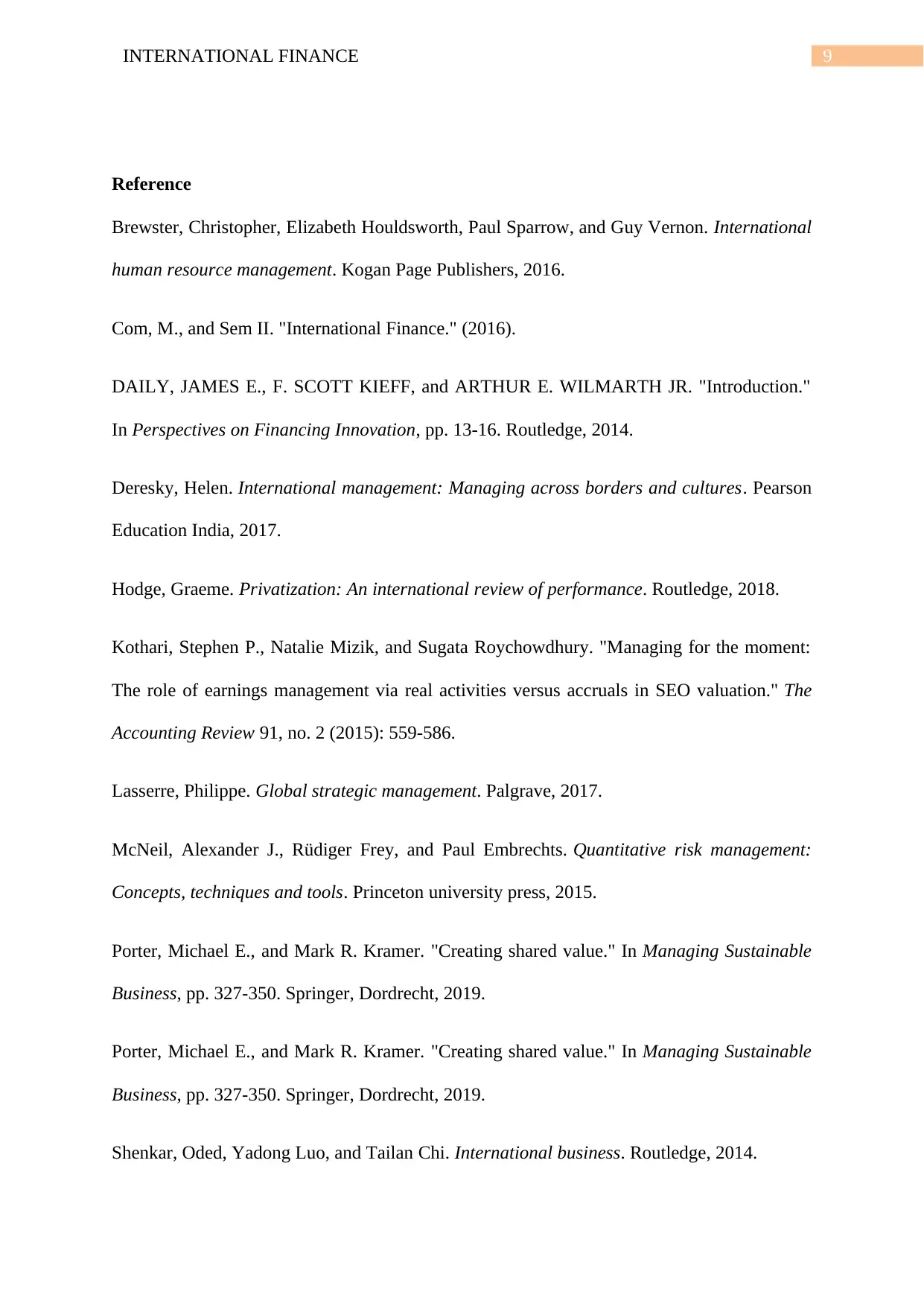
9INTERNATIONAL FINANCE
Reference
Brewster, Christopher, Elizabeth Houldsworth, Paul Sparrow, and Guy Vernon. International
human resource management. Kogan Page Publishers, 2016.
Com, M., and Sem II. "International Finance." (2016).
DAILY, JAMES E., F. SCOTT KIEFF, and ARTHUR E. WILMARTH JR. "Introduction."
In Perspectives on Financing Innovation, pp. 13-16. Routledge, 2014.
Deresky, Helen. International management: Managing across borders and cultures. Pearson
Education India, 2017.
Hodge, Graeme. Privatization: An international review of performance. Routledge, 2018.
Kothari, Stephen P., Natalie Mizik, and Sugata Roychowdhury. "Managing for the moment:
The role of earnings management via real activities versus accruals in SEO valuation." The
Accounting Review 91, no. 2 (2015): 559-586.
Lasserre, Philippe. Global strategic management. Palgrave, 2017.
McNeil, Alexander J., Rüdiger Frey, and Paul Embrechts. Quantitative risk management:
Concepts, techniques and tools. Princeton university press, 2015.
Porter, Michael E., and Mark R. Kramer. "Creating shared value." In Managing Sustainable
Business, pp. 327-350. Springer, Dordrecht, 2019.
Porter, Michael E., and Mark R. Kramer. "Creating shared value." In Managing Sustainable
Business, pp. 327-350. Springer, Dordrecht, 2019.
Shenkar, Oded, Yadong Luo, and Tailan Chi. International business. Routledge, 2014.
Reference
Brewster, Christopher, Elizabeth Houldsworth, Paul Sparrow, and Guy Vernon. International
human resource management. Kogan Page Publishers, 2016.
Com, M., and Sem II. "International Finance." (2016).
DAILY, JAMES E., F. SCOTT KIEFF, and ARTHUR E. WILMARTH JR. "Introduction."
In Perspectives on Financing Innovation, pp. 13-16. Routledge, 2014.
Deresky, Helen. International management: Managing across borders and cultures. Pearson
Education India, 2017.
Hodge, Graeme. Privatization: An international review of performance. Routledge, 2018.
Kothari, Stephen P., Natalie Mizik, and Sugata Roychowdhury. "Managing for the moment:
The role of earnings management via real activities versus accruals in SEO valuation." The
Accounting Review 91, no. 2 (2015): 559-586.
Lasserre, Philippe. Global strategic management. Palgrave, 2017.
McNeil, Alexander J., Rüdiger Frey, and Paul Embrechts. Quantitative risk management:
Concepts, techniques and tools. Princeton university press, 2015.
Porter, Michael E., and Mark R. Kramer. "Creating shared value." In Managing Sustainable
Business, pp. 327-350. Springer, Dordrecht, 2019.
Porter, Michael E., and Mark R. Kramer. "Creating shared value." In Managing Sustainable
Business, pp. 327-350. Springer, Dordrecht, 2019.
Shenkar, Oded, Yadong Luo, and Tailan Chi. International business. Routledge, 2014.
Paraphrase This Document
Need a fresh take? Get an instant paraphrase of this document with our AI Paraphraser
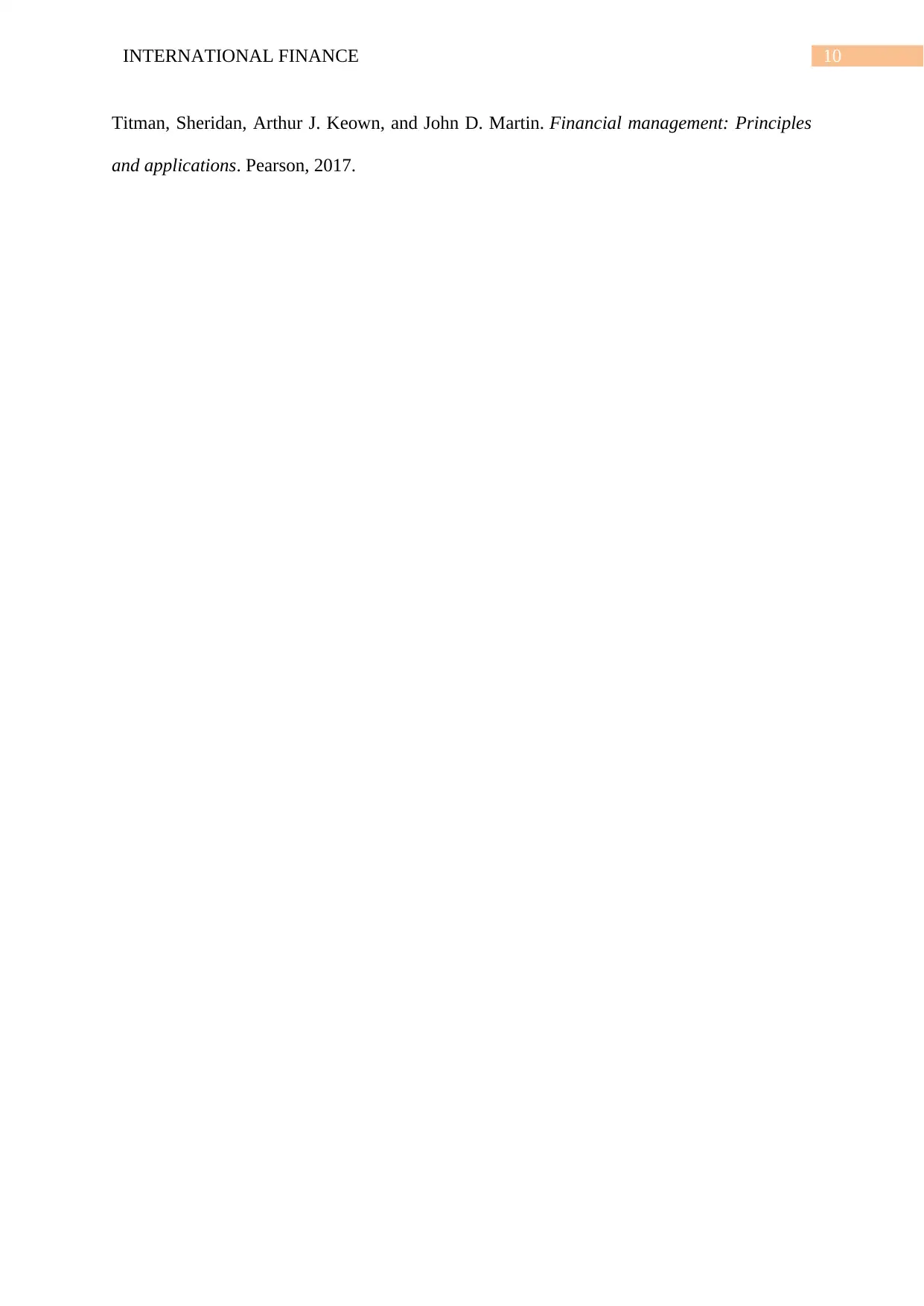
10INTERNATIONAL FINANCE
Titman, Sheridan, Arthur J. Keown, and John D. Martin. Financial management: Principles
and applications. Pearson, 2017.
Titman, Sheridan, Arthur J. Keown, and John D. Martin. Financial management: Principles
and applications. Pearson, 2017.
1 out of 11
Related Documents
Your All-in-One AI-Powered Toolkit for Academic Success.
+13062052269
info@desklib.com
Available 24*7 on WhatsApp / Email
![[object Object]](/_next/static/media/star-bottom.7253800d.svg)
Unlock your academic potential
Copyright © 2020–2025 A2Z Services. All Rights Reserved. Developed and managed by ZUCOL.





